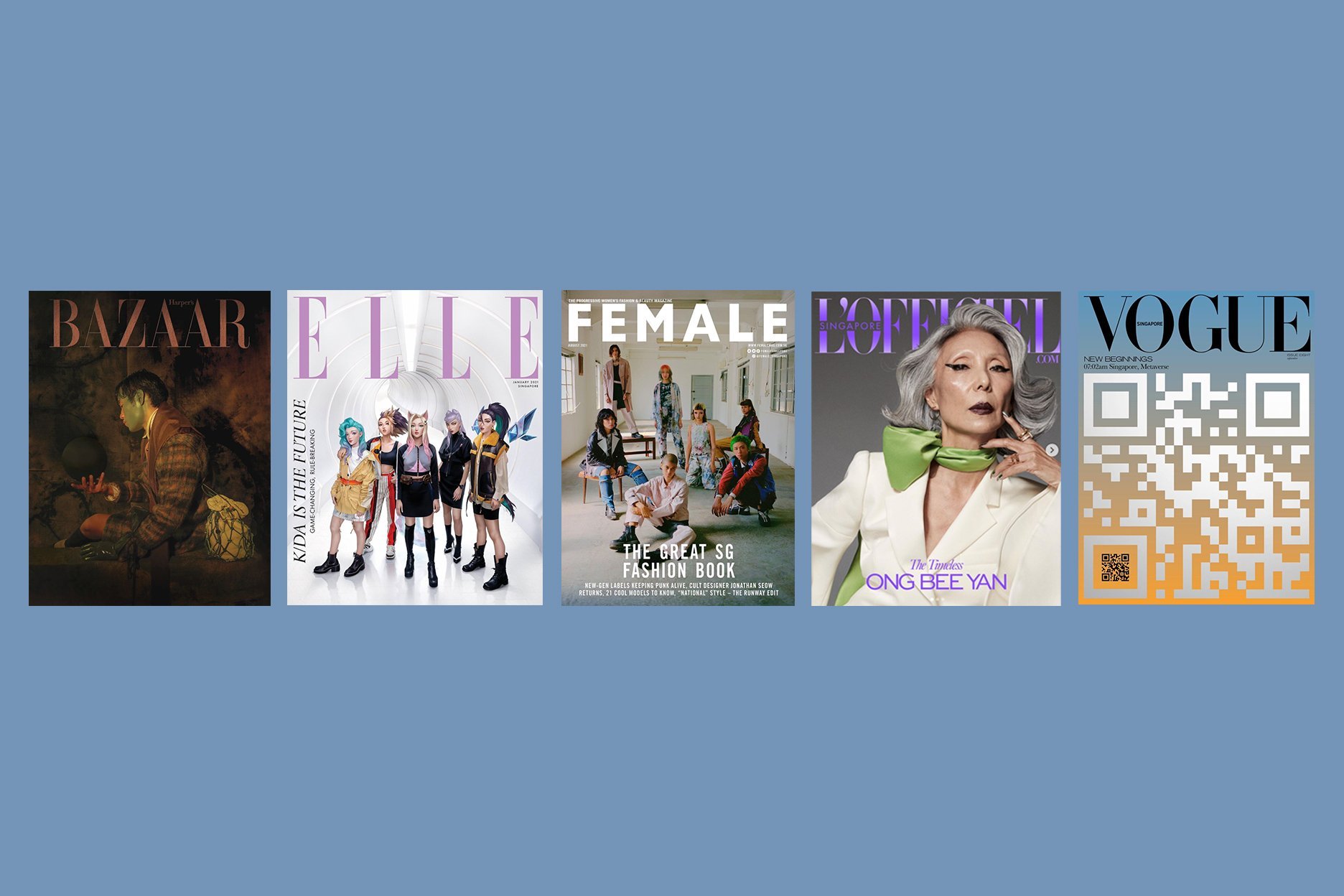A Critical Snapshot of Singapore Fashion Journalism in 2021
Vogue Singapore, Harper’s Bazaar Singapore, Elle Singapore, Female Singapore, and L’Officiel Singapore
By Weiqi Yap
From left: Harper’s Bazaar Singapore November 2021 digital cover; Elle Singapore January 2021 cover; Female Singapore August 2021 cover; L’Officiel Singapore March 2021 digital cover; Vogue Singapore September 2021 cover.
Last May, Harper’s Bazaar Singapore unveiled its June 2021 cover, fronted by 16-year-old Hong Kong socialite and model Ella Yam. The issue was themed ‘The Escape Issue’ as a cursory but topical reference to the Hong Kong-Singapore travel bubble amid the evolving circumstances of Covid-19. A cross-section of fashion journalism at any given point in history can often hold up a mirror to cultural events. Larger news outlets have attempted to dissect glossy fashion magazines as a barometer of change in the fashion industry. The New York Times, for one, does a yearly audit of the diverse representation found in major glossy women’s magazines.
While fashion journalism in Singapore is hardly political, a look back at the issues by various publications can tell us a lot about the potential and objective of a fashion magazine in 2021 Singapore.
In an effort to document Singapore fashion’s first full year in the throes of the pandemic, Fashion & Market looked to the covers and contents of five glossy fashion magazines based in Singapore: Vogue Singapore, Harper’s Bazaar Singapore, Female Singapore, L’Officiel Singapore, and Elle Singapore. This selection is not reflective of the breadth of fashion publications we have here in Singapore, and is certainly non-exhaustive1 in its observations of local fashion journalism. For the purposes of specificity, these publications were selected for their common demographic and reach. They are explicitly labelled as fashion and lifestyle publications, and by extension, have a clear focus on fashion. These magazines also represent a wide readership that is by default interested in fashion, beauty, culture and/or lifestyle subjects, but may not necessarily have a specialist niche interest in these areas.
In dissecting the issues of these five magazines in the past year, we hope to glean a brief snapshot of what the fashion press in Singapore cared about in 2021: what they tried to say, what captured their attention, and what they may have overlooked. The following trends emerged across the five Singapore fashion magazines: a heightened spotlight on local talent; a growing engagement with the digital space; and a collective interest in “breaking the rules”.
Local Faces and Voices
There was a notable spotlight on Singapore-based talent in 2021. The idea of profiling ‘stylish locals’ is not new in Singapore fashion journalism. Our national newspapers have long featured street style in their lifestyle sections, often in a rapid-fire Q&A format asking about their occupation, what they are wearing, and where they like to shop. Moving beyond such coverage, there was a greater focus on the local fashion community in 2021, enlisting its members not only as stylish subjects to profile, but as emerging talent and experts in their field. This also extends to editorial decisions that venture beyond casting local models, but content that engages in conversations about the very industry and milieu these magazines operate in.
Female Singapore’s August issue, ‘The Great SG Fashion Book’, marked its first cover featuring Singapore labels, namely Fassbender and Melloncollie, Ther Yang, and Youths in Balaclava. These brands were styled on young creatives and emerging faces in Singapore’s modelling scene. The contents of this issue were Singapore-centric, too. ‘Humans of SG Fashion’, a 20-page feature by senior features writer Keng Yang Shuen, sought opinions and insights from figures within the Singapore fashion industry, citing “their observations of and aspirations for style on this little red dot”. From educators to photographers to former models, the result is a reflexive look at Singapore’s fashion scene from the inside. For L’Officiel Singapore’s March issue, eight Singapore-based women of varying ages and professions fronted a digital cover each. These ranged from 65-year-old model Ong Bee Yan to Circe Henestrosa, fashion curator and Head of Fashion at LASALLE College of the Arts. In Vogue Singapore’s July/August issue, ‘Breath’, associate fashion features editor Maya Menon spoke to Singapore fashion creatives, Youths in Balaclava, Samuel Xun, and Rachael Cheong of Closet Children on the subject of mental health in the fashion industry. Later in its October issue, Menon penned a story on three first-generation tailors in Singapore, celebrating and documenting their trade.
These journalistic endeavours signal a heightened reflexivity in the dialogue surrounding local fashion, and an encouraging shift where Singapore fashion magazines are generating discourse about Singapore fashion. Given the nature of these titles, which are licensees of global magazines, with the exception of Female Singapore2, fashion magazines in Singapore have tended to serve as vehicles of native advertising, with little to distinguish them from their parent titles in larger fashion capitals. Of course, the product-driven pages of these magazines are not dissimilar to the shopping pages found in fashion magazines of the past. Yet the growing voices of industry figures themselves, as platformed by a younger generation of fashion writers and editors, demonstrates that Singapore fashion journalism is evolving, and maturing.
Entering the Metaverse
Singapore fashion magazines increasingly engaged with new tech, particularly Augmented Reality (AR), Non-Fungible Tokens (NFT), and virtual avatars. The onset of the metaverse is by and large a 2021 development. Meanwhile, the conversation surrounding virtual fashion has gained significant traction since Covid-19. With shrunken editorial budgets and limited access to overseas photographers, models and stylists, luxury brands and magazines alike have been experimenting with this intangible medium as a newfound route to commerce and community-building.3
Elle Singapore began the year with its January cover fronted by K/DA, a virtual K-pop girl group consisting of characters from the multiplayer video game, League of Legends. Shot on an iPhone, the cover depicts the five virtual idols against a photograph of a tunnel in Singapore, with this being the only element in the cover that exists in the material world. Vogue Singapore has been carving out a niche as a spearhead of fashion and technology since its pandemic-period launch in September 2020. Its September 2021 anniversary issue, ‘New Beginnings’, marked the first NFT Vogue cover, with one featuring the work of 3D artist Chad Knight and Singapore-based design studio, Baëlf Design, and the other a collaboration between virtual fashion pioneer The Fabricant and Singapore NFT artist, Shavonne Wong.
In a similar vein, there has also been a palpable shift in the significance of a magazine cover in the past year. All five of the fashion magazines in question dropped multiple covers several times over the course of the year. Some of them opted for the more traditional strategy of releasing multiple print covers in an attempt to drive print sales, and they all unveiled digital covers at some point throughout the year. Female Singapore had four issues with multiple covers, often releasing upwards of two covers per issue. And Harper’s Bazaar commissioned Singapore-based creatives to create a whopping 20 covers in celebration of its 20th anniversary. As online real estate continues to overshadow newsstands, it is no accident that the emphasis on digital covers has coincided with the pandemic and our unwavering online presence.
Breaking the Rules
In the last year, fashion magazines in Singapore also demonstrated a collective interest in “breaking the rules”, dedicating at least one issue in the year to challenging said rules and norms of the industry, or of fashion magazines. Elle Singapore’s January issue was accompanied with the tagline, ‘Game-Changing, Rule-Breaking’. Female Singapore produced two issues that explored a similar attitude, with its March edition titled ‘The No-Rules Edition’, and its June edition was dubbed ‘The Fashion Activity Book’, conceptualised as an accompaniment to stay-home boredom, with over 100 pages of interactive quizzes, games, and DIY projects – a less obvious allusion to rule-breaking, but an experimentation of the magazine format nonetheless. The rules being broken here were the confines of a fashion magazine’s function and editorial structure. With games instead of shopping pages, readers are granted lo-fi fun and agency over the pages, as opposed to passive skimming. Vogue Singapore’s February issue, themed ‘Touch’, while not thematically dedicated to rule-breaking, was labelled ‘Unsuitable For The Young’ on newsstands. The issue contained a fully nude shoot of women of different ages in the Beauty section, alongside a shopping line-up of vibrators and discussions on women’s sexual health. In its Lifestyle section, senior writer Chandreyee Ray lent insight into the labour of Singaporean sex workers.
The label is part of a directive by the Infocomm Media Development Authority (IMDA), Singapore’s governing body for media, including magazines. It allows general lifestyle magazines to publish not more than four issues a year which feature mature content, such as depictions of nudity and sex—and these issues must be poly-bagged, and carry the consumer advisory label. The theme of ‘rule-breaking’ can be incredibly broad and vague in the context of fashion publishing. This is often expressed aesthetically, where the styling choices of a fashion spread may be superlatively described as irreverent or rebellious. The tacit constraints of press censorship in Singapore are often untouched by general interest publications, let alone fashion magazines. But the past year has shown brief instances of Singapore fashion magazines attempting to challenge the conventions of fashion publishing, be it through format or editorial strategy. As long as the expectations of readers in Singapore continue to evolve, so too must the contents of our fashion magazines.
Notes
National news outlets such as The Straits Times and Channel News Asia have explored Singapore fashion in their daily broadsheets and on their digital platforms. Other outlets that explore fashion in Singapore beyond print media include podcasts such as In The Vitrine and Re:Wear.
Female Singapore launched in Singapore in 1974 under the now-defunct publisher, Blu Inc Group, and was later acquired by Singapore Press Holdings in 2004.
For detailed insights on the opportunities for fashion in the metaverse, see McKinsey & Company and The Business of Fashion’s ‘The State of Fashion 2022’ report here.











